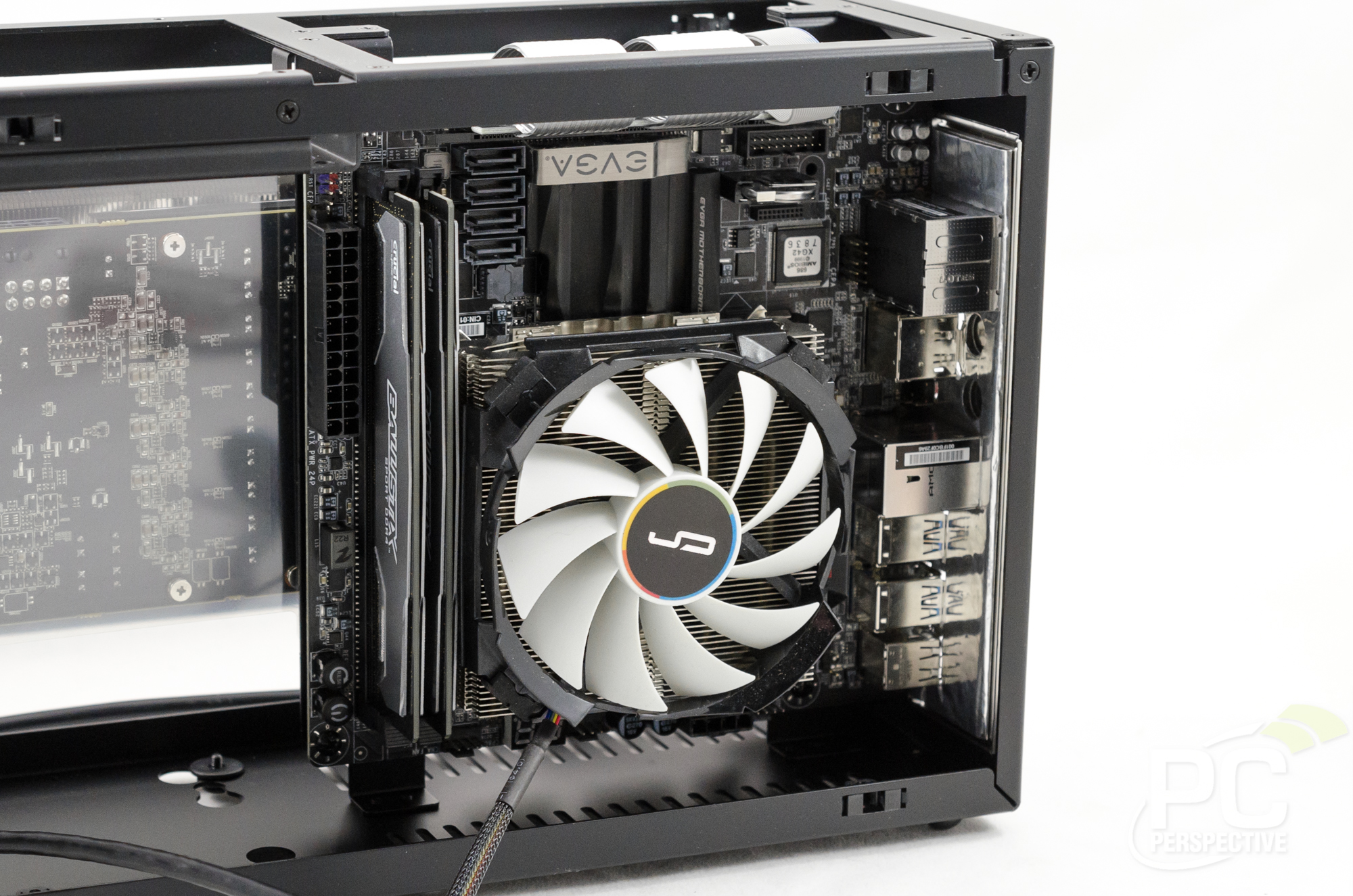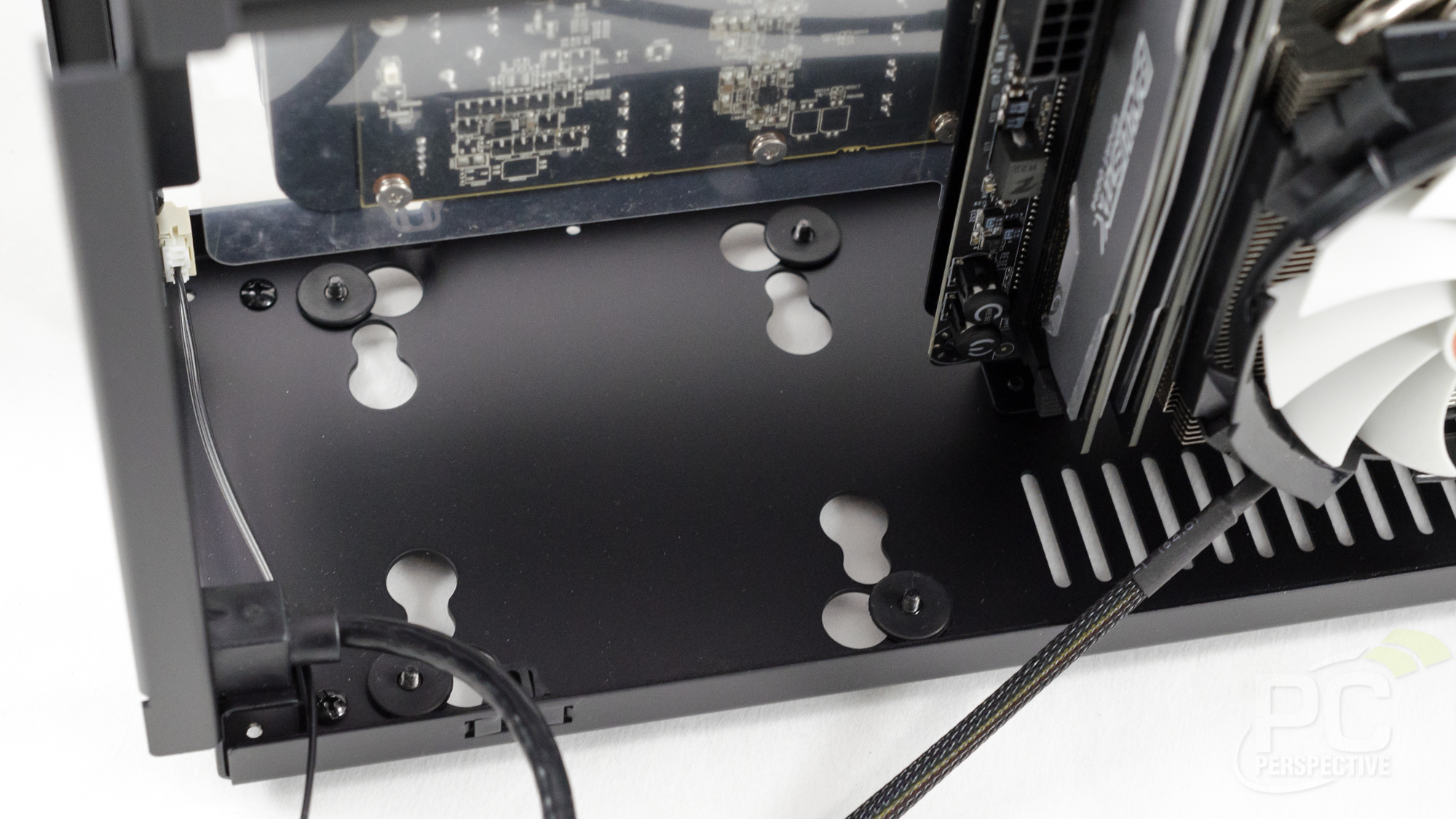Interior and Build Process
Step one in building with any computer case: remove the side panels!
These aluminum sides are each connected with two screws on the bottom, and the rest of the panels are held in place with Lian Li's push-pin connectors. The screws are an interesting addition, but do make the case feel quite solid when it is assembled.
Inside the A4-SFX features a dual-chamber design, which makes the ultra-small size of the A4-SFX all the more impressive. On this side the motherboard and SFX power supply are attached, and you will notice the PCI Express riser card cable already installed (protected with bubble wrap from the factory). CPU cooler height is limited to 48 mm, which still allows for quite a few options from various vendors.
And around back we see the space for the graphics card behind the system components, with the PCIe slot installed and ready for the GPU.
The primary storage location is on the case floor beneath the PSU, though the use of an SFX-L unit limits this to a single SSD or 2.5 inch hard drive, where shorter SFX PSUs allow a dual-drive stack with the included aluminum bracket.
Building the System
I'll get right into the build here, first mentioning that the top panel also needs to come off. This is a large, L-shaped panel held in place with screws, and once removed we have the full access needed for this very tight build.
The motherboard is installed in an inverted orientation, which actually works perfectly for managing cables with so little space, given the placement of motherboard power connectors in relation to the PSU. My SFX-L power supply is a modular design with flat, ribbon-style cables that are fairly short, and I had no trouble connecting everything.
Looking at the other side we see the largest GPU I had on hand, an aftermarket AMD Radeon R9 290X from XFX that features a longer (and taller) cooler than the reference card. The 295 mm GPU length limit is more than sufficient, and I had a little more vertical space than I needed as well.
If needed, a drive could be mounted directly to the floor of the case, rather than using the bracket; but I proceeded with the bracket in place.
A pair of SSDs can be installed on the floor of the case if a shorter SFX power supply is used
One more storage option is available, as the front panel can be removed to reveal mounts for another 2.5-inch drive up front.
I was concerned about a fully-modular SFX-L PSU fitting properly, and while it was a little snug it did work with the drive bracket installed. (This would have been a non-issue without the bracket.) This is good to know, considering the benefits of a modular SFX-L PSU, with their typically quieter fans and reduced cable mess.
Next we'll have a look at the finished build, and then check out thermal and noise performance.

















Got the case and really now
Got the case and really now just waiting on Ryzen itx motherboards. There are definitely cheaper itx cases but almost none this small.
Your in luck, Biostar just
Your in luck, Biostar just lunched it’s mitx board.
https://videocardz.com/press-release/biostar-debuts-worlds-first-mini-itx-motherboard-for-amd-ryzen
Yeah they look good but I’d
Yeah they look good but I’d trade in that dvi port for more usb ports. And I think MSI or Gigabyte announced/leaked a possible itx board.
So you’re saying the gpu
So you’re saying the gpu temps are better than the other cases?
I don’t think you’ll see much
I don't think you'll see much of a difference between temps open-air vs. inside the case, no. It is a very well-ventilated design, with vents above, below, and next to the GPU cooler. Much better ventilation than the typical enclosure; but no additional airflow from case fans, either.
Man that thing is as tight
Man that thing is as tight and a nuns…. *cough* joke book!
Looks good for a front room setup but I wouldn’t want to lose a half decent cooler on a gaming pc.
I’m still rocking Fractal Design’s Node 304. It’s not the smallest but still small. AIO cooler, full length windforce x3, 4x Noctua quiet fans and 2 SSDs with room to spare.
Really can’t see me ditching it any time soon.
Might be a good option for some if this is difficult to get hold of.
awesome review of yet another
awesome review of yet another gorgeous aluminum mini itx case
you answered all the questions as to my concerns with tolerances in the build for heatsink, psu, and graphics along with everything else
still can’t find the PC-Q17 WX for sale and this think is only available on kickstarter at the end of May
and those biostar mini itx 350 and 370 boards are also no where to be found
so want to build a system, but no one wants to take my money
thanks so much for doing another aluminum case review
maybe you can get one of these to review: LIAN LI PC-V359WRX Black/Red Aluminum MicroATX Mid Tower Computer Case
yet another one I would be happy to use, but always shows out of stock at newegg; i don’t know if it is discontinued or a new product that is still not in stock
Sweet little case! Could
Sweet little case! Could surely do with a better name though,
“whats that case?”
“oh its a Dancase”
“whos Dan and why do you have his case?”
yah see?
Can you fit a quad channel,
Can you fit a quad channel, 44 thread, car priced build in there? Yes, yes you can…
Dan is about to launch
Dan is about to launch another kickstarter campaign at the end of May for the V2 version of the case.
If only it wasn’t £250 🙁
If only it wasn’t £250 🙁
Looked pretty hard at one of
Looked pretty hard at one of these as an alternative to my ncase M1, but it seems like HSF and motherboard compatibility are issues. Yes, there are options in the size range required, but as soon as you start looking to overclock the CPU a bit, the choice narrows a lot. Certain motherboards like the Asus ITX boards with the weird VRM daughterboard setup run into clearance problems and ram compatibility is a challenge. Even if I ignored the fact that I’d be replacing one expensive tiny case with another, the limitations seemed like a bit too much of a sacrifice.
It is beautifully designed though.
fair play to the reader who
fair play to the reader who sent this in for review. really wanted to see more of this in depth. would love a build video [or a tiny tom logan~ type in depth review about it] but i realise its too late and probably too much too ask. i bought one of the first batch of ncase m1’s and had i not i would have insta bought this, i think the concept of both of them is beautiful.
Just a quick update – I
Just a quick update – I purchased the A4-SFX through the initial kickstarter.
I LOVE it, but it will perform better with a blower fan GPU as it helps exhaust the heat immediately.
I’m running a Silverstone SX500-LG to power:
Asus Z97I-Plus, i5 4570 (slightly undervolted and OCed), 2x8GB Corsair Vengeance LP
Gigabyte GTX 1080 FE (previously Strix 970)
1TB 840 EVO **AND** 2TB Samsung Spinpoint
It is 100% possible to run 2×2.5″ drives with an SFX-L PSU.